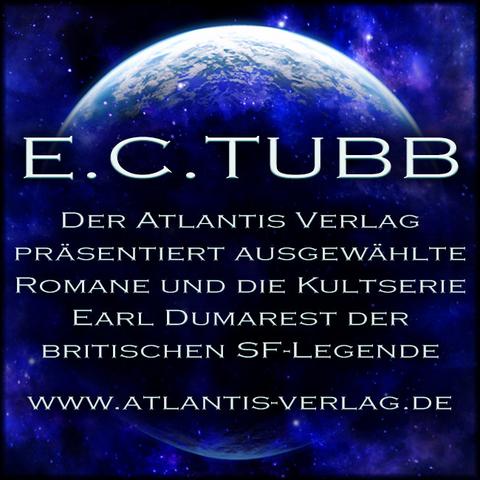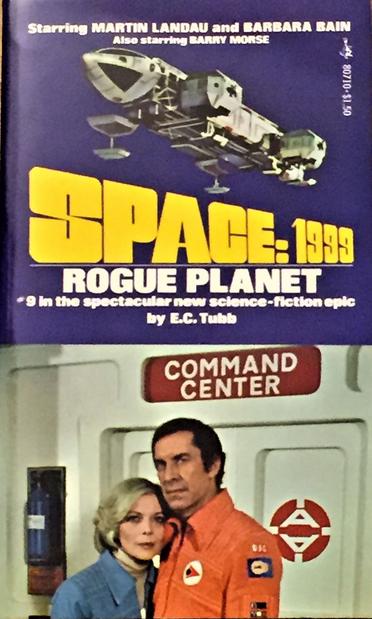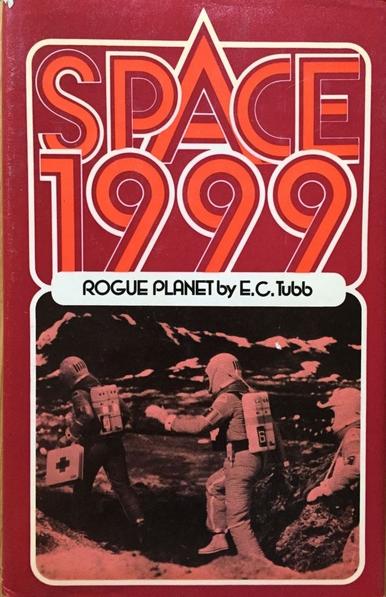Short Story Reviews: E. C. Tubb’s “Without Bugles” (1952), “Home is the Hero” (1952), and “Pistol Point” (1953)
The following reviews are the 33rd, 34th, and 35th installments of my series searching for “SF short stories that are critical in some capacity of space agencies, astronauts, and the culture which produced them.” Some stories I’ll review in this series might not fit. And that is okay. I relish the act of literary archaeology.
For this post I’ve selected three short stories about the horrific conditions on a colonized Mars by E. C. Tubb (1919-2010) that appeared in the British SF magazine New Worlds. Along with three additional tales, they were fixed-up as the novel Alien Dust (1955).1 I “blame” the “Friend of the Site” John Boston for my renewed interest in Tubb’s bleak stories. I recently acquired Boston’s three-volume commentary on pre-Moorcock New Worlds and Science Fantasy.2 Boston correctly describes Tubb’s earlier stories as preoccupied with the “domestic lives of spacefarers” in often overwritten and maudlin strokes.3 Regardless, I found the topics he explored worth my time. I’d only previously read his later short story “The Seekers” (1965) and The Space-Born (variant title: Star Ship) (1955). Considering his hard-boiled sensibilities, I imagine a substantial slice of his fiction would fit this series.4
Previously: Philip K. Dick’s “Explorers We” (1959) and James Tiptree, Jr.’s “Painwise” (1972).
Up Next: John Wyndham’s “The Man From Beyond” (variant title: “The Man from Earth”) (1934)
- Gerard Quinn’s cover for New Worlds, # 13, ed. John Carnell (January 1952)
3.5/5 (Good)
“Without Bugles” first appeared in New Worlds, # 13, ed. John Carnell (January 1952): You can read it online here.
As with most E. C. Tubb stories, “Without Bugles” starts with a punch: “The man writhed on the narrow cot, and fought for his life” (52). The man in question is one of many colonists on Mars afflicted with a futuristic black lung–“an industrial disease. Silicosis they called it once”–caused by radioactive dust (54). The origin of the radioactivity isn’t clear. Dust cannot be avoided on Mars. It seeps through all seals. It gathers in corners. It bypasses masks. Into the colony of the dead and dying and those that tend them, Anders, the Secretary for Extra-Planetary Affairs, and Pat Easton, a vivacious and idealistic reporter for Trans-World Communications arrive on an infrequent rocket. The purpose of the commission? Anders gets straight to the point: “Congress has poured billions of dollars into this project. When are you going to start paying it back?” (56). Pat proposes the fate of the colony can be swayed by a positive depiction of the heroic colonists.
The narrative follows Dick Banner (the perfect noir name) who struggles with the heroic idealism regurgitated by Pat–“Heroes! Pioneers! The vanguard of all Earth, breaking new frontiers!” (55)–in her attempt to save the colony. Dick, on the other hand, who has experienced the brutal reality firsthand agrees with Anders’ assessment that the Mars isn’t suitable for short-term investment. Instead, Dick surmises, “it will take years. Billions. Thousands of men. It may take a generation” (60) in order for Mars to be livable. And thousands will die along the way. And when Pat learns of the impact of Martian dust on Dick, whom she feels drawn too, all illusion comes crashing down.
As with the other two stories in this post, Tubb reframes our romantic conception of Mars. The colony itself is not depicted, in its incubatory state, as a place of wonder. Instead “it was a depressing sight,” a mere “huddle of low rounded buildings” that gave the “appearance of pre-fabrication” (54). Due to a diet of yeast products, the colonists must even be “conditioned” to dislike the finer pleasures of earth (tobacco, coffee, milk, alcohol). It’s a cynical story. Tubb’s characters peer underneath the romanticism of it all and see the true movement of the gears. Gears gummed and greased by the blood of humanity and the vapors of public opinion.
Recommended for fans of the theme. I assume most others will find it a bit on the nose.
- Gerard Quinn’s cover for New Worlds, # 15, ed. John Carnell (May 1952)
3.5/5 (Good)
“Home is the Hero” first appeared in New Worlds, # 15, ed. John Carnell (May 1952): You can read it online here.
At some chronological point after “Without Bugles” (1952), the Mars colony gets a new lease on life–the discovery of uranium. Growing nuclear tensions on Earth pull the colony into its arms race, a colony that must immediately be exploited. Unfortunately, the public has forgotten the plight of its dying men. Another punchy sentence begins the madness: “Gravity clawed at him, dragging down his head, bowing his back, sending protesting quivers along the muscles of thighs and shoulders” (79). Major Randolph arrives of Earth. The gravity turns him into an invalid. He spends his days in his bathtub observing his once-athletic limbs, attended by a masseur, and further disturbed by the why of his arrival on Earth. He’s been recalled for a propaganda mission: “it is essential that the original enthusiasm attending the initial colonisation of Mars be revived” (83). The problem? Life of Mars is miserable and the low gravity means you cannot return to Earth for long spells. Also, no one is to know the why–to facilitate the manufacture of weapons of mass destruction. Randolph is torn on the latter point. He wants Mars to have a new lease on life. He knows that it might come at the expense of countless lives on Earth.
The masterplan to restart the colony? Get women desperate for husbands to volunteer. Randolph isn’t content to regurgitate the jingoistic nonsense he’s been told to parrot. The women wait for him to tell them that they’ll be heroines. Instead, he lays out the brutal reality of life: “Don’t expect to find big handsome men in the colony. They’re all skinny little runts […] No coffee. No cosmetics. No fancy clothes. […] You’ll live on yeast, and drink water partly reclaimed from waste from your own body. You’ll live in huts of tamped dirt. You’ll have no books, no cinema, little privacy” (87). He’s accused of sabotaging the project until he convinces them of the necessity of his ways.
At this point the narrative oddly shifts to another victim of the human ambition to conquer the stars: John Lomas, ‘Atom’ Lomas (90). Rudolph is summoned by Lomas’ sister to John’s bedside. John participated in an earlier expedition to the Moon. The man lies in bed dying. The story becomes a rumination on the nature of heroism. The hero only exists when they’re strapping and young and healthy and in the public eye. As with Malzberg’s astronaut hero on welfare, Tubb ruminations: “what happens to heroes–when they live too long?” (93). The implication is clear. The men on Mars might be heroes in a time of need. But what happens when public opinion shifts to other arenas?
- Gerald Quinn’s cover for New Worlds, # 21, ed. John Carnell (June 1953)
2.75/5 (Below Average)
“Pistol Point” first appeared in New Worlds, # 21, ed. John Carnell (June 1953): You can read it online here.
Nuclear war ravaged Earth. Mars’ uranium is no longer needed. The women recruited in the previous story have returned to Earth.5 The resupply rockets come more infrequently with less and less supplies. Mars’ demands for basic supplies to start hydroponic farms in order to be self-sufficient go unheeded. As with the other two tales, another punchy sentence leads things off: “He rested in a shallow grave scooped from the fine, red dust, a small man with pipestem limbs and shrunken cheeks” (41). On the death of the previous leader of the colony, Ventor, Carl Denton takes over. At some point Mars had become a penal colony (the internal chronology of the stories isn’t exactly clear) and Carl decides to channel his criminal tendencies to rescue the colony. Boston correctly points out in his brief review, this story was written before terrorism periodically dominated the news cycle–the plot hits a bit different as a result.
As with the other two, Tubb narrows in on the central, and all too flighty, role of public opinion–mediated through the news–in the survival of the colonists. And unlike the other two, Tubb moderates the draconian implications of his scenario. Carl must believe he will kill millions but others around him have a bit more heart despite the redolent desperation afflicting all. There’s even a bit of light at the end of the tunnel. Mars might be able to escape the cycle of obsession and abandonment that plagued earlier generations.
Notes
- The six stories that form the novel: “Without Bugles” (1952), “Home is the Hero” (1952), “Men Only” (1952), “Alien Dust” (1953), “Pistol Point” (1953), and “Operation Mars” (1954). I’m intrigued enough to cover the other three at a later point. ↩︎
- John Boston and Damien Broderick’s Building New Worlds: 1946-1959: The Carnell Era, Volume One (2013). See the later two volumes as well: New Worlds: Before the New Wave, 1960-1964: The Carnell Era, Volume Two (2013) and Strange Highways: Reading Science Fantasy, 1950-1967 (2013). ↩︎
- Boston, 150. ↩︎
- Other Tubb stories Boston indicates that might fit the bill include: “Homecoming” (1954), “Precedent” (1952) [maybe], “Heroes Don’t Cry” (1953), “Rockets Aren’t Human” (1953), “Unwanted Heritage” (1952), “No Place for Tears” (1957), “School for Beginners” (1955), “The Veterans” (1955), “Into Thy Hands” (1954), “Samson” (1957), “The Greater Ideal” (1957), etc. ↩︎
- I thought “Home is the Hero” established that people couldn’t return after any extended time? This also implies that Randolph’s strategy wasn’t successful. I assume these internal discrepancies were smoothed over in the novel version. ↩︎
For book reviews consult the INDEX
For cover art posts consult the INDEX
For TV and film reviews consult the INDEX
#13 #15 #1950s #21 #bookReviews #ECTubb #sciFi #scienceFiction








